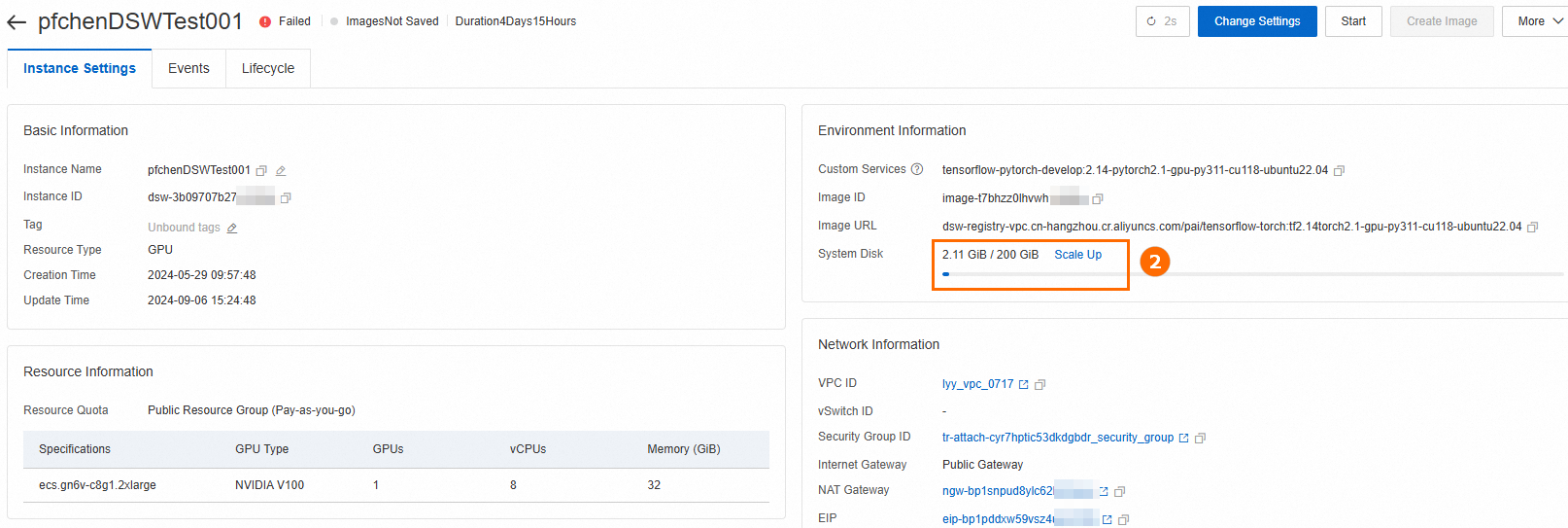This topic provides answers to some frequently asked questions about Data Science Workshop (DSW).
Questions
What is DSW?
DSW is a cloud-native machine learning and data science platform provided by Platform for AI (PAI). DSW comes with JupyterLab, WebIDE, and Terminal. You can also establish a remote connection between your on-premises device and DSW over SSH to use various computing resources and environments provided by DSW. DSW allows you to write and execute code online, submit the code as offline tasks, and then download the generated trained models.
How do I download a folder from Notebook?
Notebook in DSW is a development environment based on open source JupyterLab. You cannot directly download a folder by right-clicking the folder. DSW provides the Notebook, WebIDE, and Terminal development environments that are interconnected in the backend. You can use Linux commands to package a folder in Terminal, and right-click the packaged folder in Notebook to download the package.
What do I do if I fail to connect to a DSW instance by using the proxy client and the "client_loop: send disconnect: Broken pipe" message appears?
When you connect to a DSW instance by using SSH, if the session is idle for a long period of time, it is automatically disconnected.

To resolve this issue, we recommend that you directly connect to a DSW instance.
How do I mount and use my NAS file system on a DSW instance?
A DSW instance comes with a system disk to temporarily store data. After the instance is stopped or deleted, the data is cleared. To permanently store data, you must mount your File Storage NAS (NAS) file system on the instance. All your NAS files are stored in the /nas directory. You can view and use the files in this directory by using DSW Terminal.
The latest version of DSW allows you to mount your NAS file system on a DSW instance only when you create the DSW instance. For more information, see Create and manage DSW instances. After a DSW instance is created, you cannot modify the instance information or change the mounted NAS file system.
If a NAS file system is mounted on a DSW instance, the NAS file system is used to permanently store data. The temporary storage of the DSW instance is no longer used.
What do I do if the "insufficient capacity of ephemeral storage" message appears when I create an image?
Cause: The system checks the available capacity of the system disk when you create an image. If the available capacity is smaller than the size of the write layer, an error is reported.
Solution: In DSW Terminal, check the disk capacity usage of the file system by using the df -h command. Make sure that the capacity that is used by the overlay does not exceed the available capacity of the /dev/vda4 directory. If it exceeds the capacity, you can configure the Custom Excluded Path parameter when you create an image.

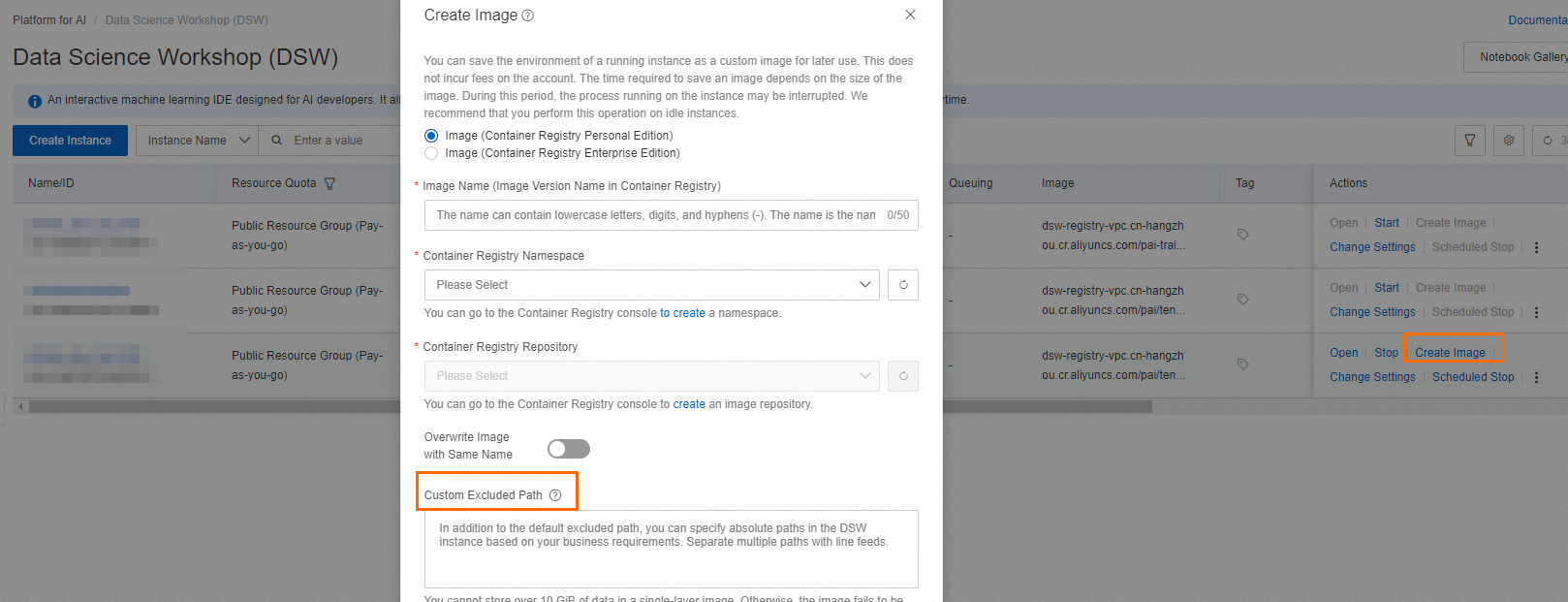
How do I use a third-party library in DSW?
To install a third-party library in DSW, run the relevant commands in DSW Terminal. Sample code:
#Install a third-party library in the Python 3 environment.
pip install --user xxx
#Install a third-party library in the Python 2 environment.
source activate python2
pip install --user xxxReplace xxx with the name of the third-party library that you want to install. After the installation is complete, choose Kernel > Restart Kernel to restart the service.
Why does the system require logon again when I pause for a period of time during the execution of machine learning code?
To ensure security, a logon session in DSW is valid for 3 hours. After the session expires, you must log on again. Task execution is not affected by logon session timeout. If you need to run a task that requires a long period of time to complete, we recommend that you run the nohup command on the Terminal interface in DSW to run the task in the background.
I established an FTP connection by using ECS and uploaded and downloaded files to a NAS file system. What do I do if the "mount:wrong fs type,bad option,bad superblock" message appears after I run the mount command?
Problem description

Solution
Before you run the
mountcommand, install the nfs-utils package.yum install nfs-utils
How do I use DSW to read data from OSS?
Go to the Terminal interface of a DSW instance and run the ossutil command to upload and download objects. Perform the following steps:
Download, install, and then configure ossutil on the Terminal interface of a DSW instance. For more information, see Install ossutil.
Upload an object to an Object Storage Service (OSS) bucket or download an object from an OSS bucket to the DSW instance. For more information, see ossutil command reference.
Why does the third-party library I installed fail to take effect?
After you run the pip command to install a third-party library and run the import command to import the library, restart the service if the library is not found. If the error persists, check whether the current environment is valid. By default, third-party libraries for DSW are installed in the Python 3 environment. Before you can install a third-party library in another environment, you must manually switch to the environment. Sample code:
Install a third-party library in the Python 2 environment.
source activate python2
pip install --user xxx
Install a third-party library in the TensorFlow 2.0 environment.
source activate tf2
pip install --user xxxReplace xxx with the name of the third-party library that you want to install.
How do I deploy a model that is generated by DSW?
Use EAS to deploy a model service
You can run commands in DSW Terminal to use the built-in EASCMD client to deploy a model service. For more information, see Create and manage DSW instances.
Download a model to an on-premises device for deployment
You can right-click a model that is generated by DSW and download the model to an on-premises device.
How is DSW billed?
DSW can be billed based on the subscription or pay-as-you-go billing method. You can select a billing method based on your business requirements. For more information, see Billing of DSW.
How do I view the bills of DSW?
If you use the pay-as-you-go billing method, you can go to the Expenses and Costs page to view billing details. For more information, see View billing details.
Why am I unable to start Docker in DSW?
DSW is runs in a container. Therefore, you cannot install Docker for DSW. The underlying virtual machine is equipped with a specific version of CUDA that cannot be changed before delivery. You can use the NVIDIA System Management Interface (nvidia-smi) to query the CUDA version.
What do I do if I fail to start a DSW instance?
Troubleshooting method: Click the name of the DSW instance, and view the error message on the Events tab.
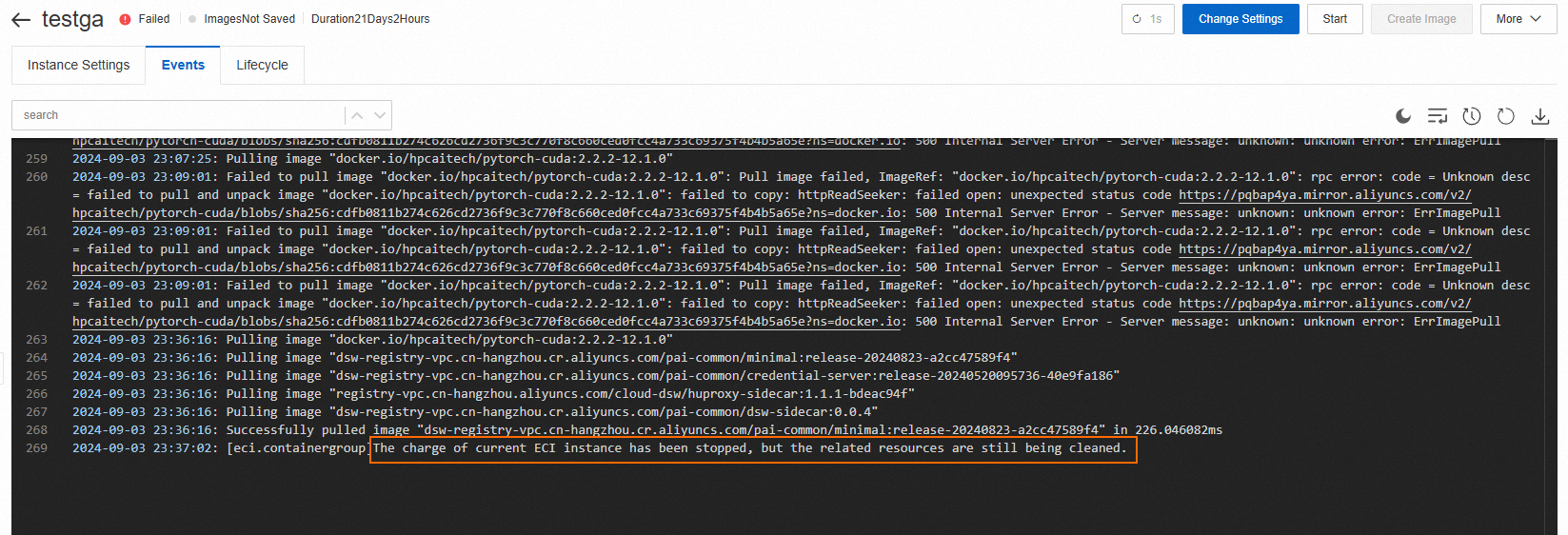
If one of the following error messages appears, the DSW instance fails to start:
Why am I unable to use bash features such as auto-completion in Terminal?
Bash features are disabled by default in specific images. You need to enter bash in Terminal and press the Enter key to enable bash features. 
What do I do if the specifications of a DSW instance do not meet the requirements for AI development in DSW?
Perform the following steps to update DSW instance specifications:
On the Interactive Modeling (DSW) page, find the DSW instance that you want to manage and click the instance name to go to the Instance Details page.
On the Instance Settings tab, click Change Settings.
In the Change Instance Settings panel, update the instance specifications.
NoteWhen you update the specifications of a running DSW instance, the update operation immediately restarts the instance. Make sure that you saved the data in the instance.
What do I do if the "Input/output error" message appears when PAI accesses the mount directory after I mount an OSS dataset?
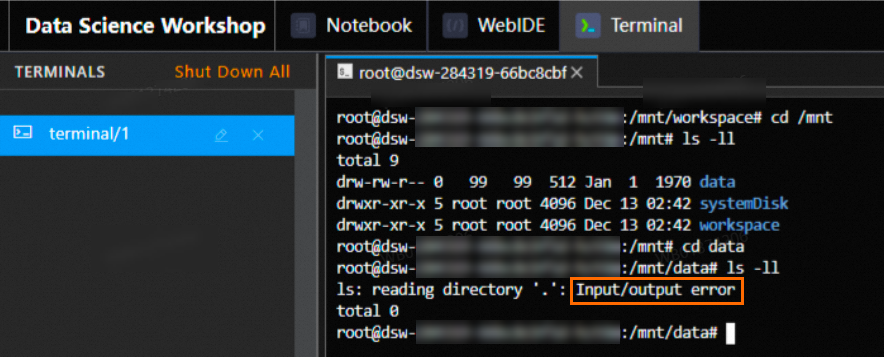
This issue occurs because OSS access permissions (AliyunPAIDLCAccessingOSSRole) are not granted to PAI. For more information about how to grant OSS access permissions to PAI, see Authorize the service-linked role.
How do I release memory when my memory usage is high?

You can use one of the following methods to resolve the issue:
If the memory usage is so high that you cannot use the command line, click Stop Instance in the upper-right corner of the development page. You can also go to the instance page of the DSW console and click Stop in the Actions column of the instance that you want to stop. Wait until the instance is stopped before you open the instance.
If you can use the command line in the instance, you can run the
topcommand on the Terminal interface of the instance to view the memory usage of all processes.%MEMis the percentage of memory used.PIDis the process ID.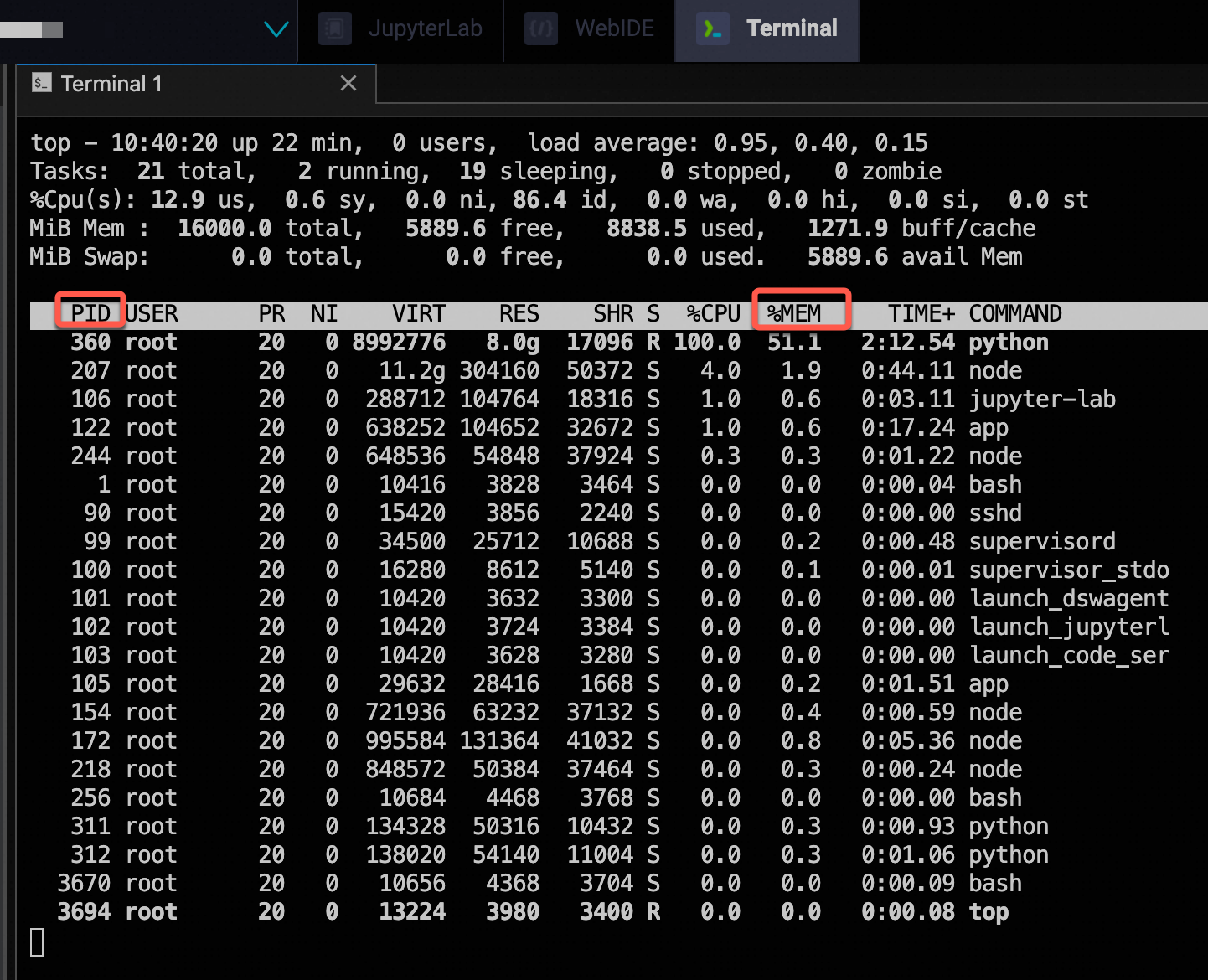
To end a process, run the following command:
kill PIDReplace PID with the ID of the process that you want to end. After the command is run, you can see the reduction in memory usage.

RuntimeError: CUDA error: too many resources requested for launch
Cause:
The resources requested by the CUDA kernel exceed the available resources. This error is generally related to hardware limitations of the GPU.
Solution:
You can try restarting the instance and rerunning the program. If that doesn’t work, you will need to select a GPU instance with higher specifications.
How much disk space does a DSW instance have?
Files and data in a DSW instance are stored on the system disk by default and come with a certain free quota. Instances created in the public resource group have a free quota of 100 GiB, while instances in the dedicated resource groups (general computing resources or LINGJUN resources) will only provide a free quota for the system disk if they meet the specification requirements. You can check the size of the free disk space on the Change Settings page.
Click the name of the instance on the Instance tab.
In the upper right corner, click Change Settings. Then, find System Disk on the page that appears.

If your disk space usage exceeds the free quota, you can choose to expand the system disk or configure mounting. For more information, see Use scenarios of expanding a system disk and mounting a dataset.

